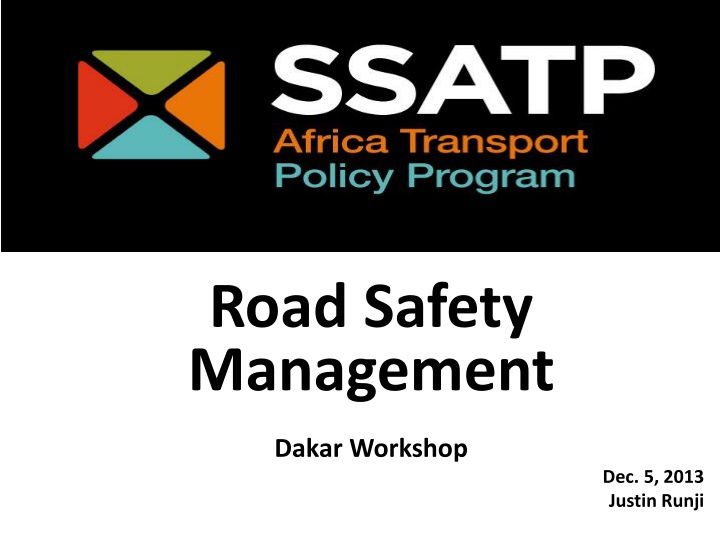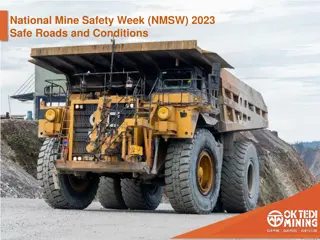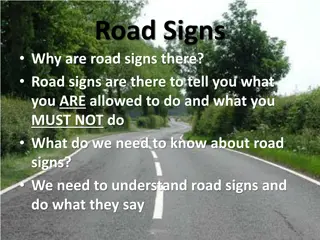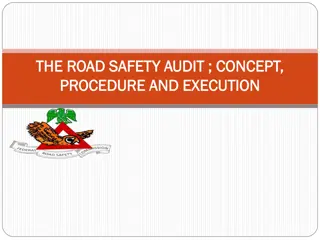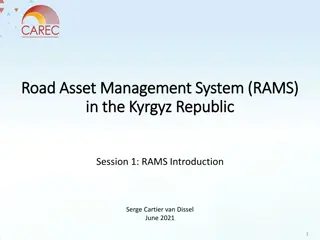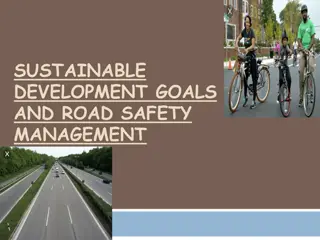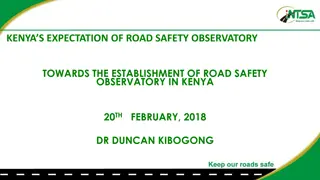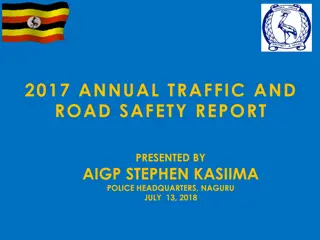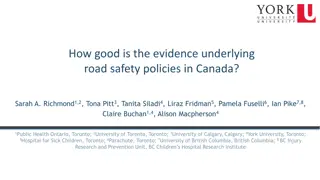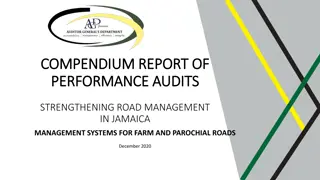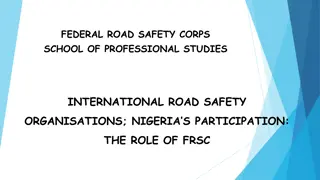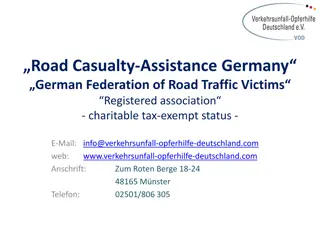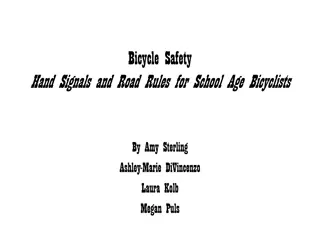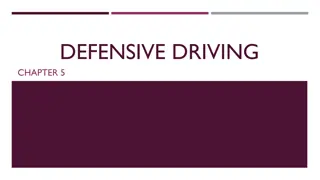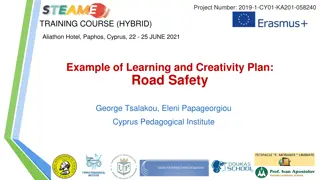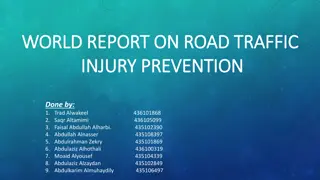Road Safety Management Workshop Insights
This content provides insights into a Road Safety Management workshop held in Dakar on December 5, 2013, focusing on initiatives, challenges, and strategies outlined by the UN Decade of Action. It covers key pillars, country strategies, the call for real improvements, and activities to enhance road safety governance and reduce fatalities globally by 2020.
Download Presentation

Please find below an Image/Link to download the presentation.
The content on the website is provided AS IS for your information and personal use only. It may not be sold, licensed, or shared on other websites without obtaining consent from the author.If you encounter any issues during the download, it is possible that the publisher has removed the file from their server.
You are allowed to download the files provided on this website for personal or commercial use, subject to the condition that they are used lawfully. All files are the property of their respective owners.
The content on the website is provided AS IS for your information and personal use only. It may not be sold, licensed, or shared on other websites without obtaining consent from the author.
E N D
Presentation Transcript
Road Safety Management Dakar Workshop Dec. 5, 2013 Justin Runji
Content The UN Decade of Action Pillars Africa Road Safety Plan of Action Basic Road Safety Management Models Public Service Challenges Conclusions 2
Background to UN Declaration Road traffic injuries can be prevented Lead Agency + Strategy + Targets = Sustainable response Initiatives and investments must be sufficient to halt or reverse road traffic deaths. 3
The UN Resolution General Assembly resolution 64/2551 of March 2010 proclaimed 2011 2020 the Decade of Action The overall goal of the Decade: to stabilize and then reduce the forecast level of road traffic fatalities around the world by 2020 4
The five pillars The above pillars are to be considered in formulating country road safety strategy 5
The Call I call on Member States, international agencies, civil society organizations, businesses and community leaders to ensure that the Decade leads to real improvements. As a step in this direction, governments should release their national plans for the Decade when it is launched globally on 11 May 2011. Mr Ban Ki-moon, UN Secretary-General 6
Pillar 1 Activities Activity 1: Adhere to and/or fully implement the major United Nations road safety related agreements and conventions (international traffic safety, road signs, traffic signals etc) Activity 2: Establish a lead agency (and associated coordination mechanisms) on road safety involving partners from a range of sectors Activity 3: Develop a national strategy (at a cabinet or ministerial level) coordinated by the lead agency Activity 4: Set realistic and long-term targets for national activities based on the analysis of national traffic crash data 7
Pillar 1 Activities Activity 5: Work to ensure that funding is sufficient for activities to be implemented e.g utilizing 10% of infrastructure investments for road safety; and Activity 6: Establish and support data systems for on-going monitoring and evaluation to include a number of process and outcome measures 8
Activity 2 underpins the other 5 Activity 1: United Nations road safety agreements and conventions Important, slightly remote (international traffic volumes; manufacturing etc) Activity 2: Establish a lead agency This is critical Activity 3: Develop a national strategy Better strategy after Activity 2 Activity 4: Set realistic and long-term targets Realism with Activity 2 Activity 5: Ensure funding is sufficient Better funding traction with Activity 2 Activity 6: Establish and support data systems Better capacity and consistency with Action 2. 9
Africa Decade Plan of Action (ADPOA) Developed through a series of consultations with member States, RECs, other key RS stakeholders during Accra Conference (2007), Dar es Salaam Meeting ( 2009) & Addis Ababa Conference (2011) Adopted by the 2nd CAMT in Nov. 2011 in Luanda Endorsed by the 18th African Union Summit (Heads of Sates) in Jan. 2012 in Addis Ababa 10
Why ADPOA? Adaptation to Africa circumstances and situation Has a framework that links efforts at all levels Country; Regional; Continental Aims to harmonized actions plan at continental level Has a tool for assessing the status of implementation 11
Key elements of the ADPOA Overall objective: Stabilize and then half road crashes by 2020 5 Pillars specific for the continent Defines expected accomplishments Monitoring indicators Responsible actors Delivery timelines - ST;MT;LT 12
Status and next key step EX.CL DEC 682 (XX) of the African Union Executive Council Decision Adopted by Committee of Africa Ministers of Transport Ratified by Africa Heads of States Next: Preparation and adoption of a road safety charter for Africa first stage completed 13
ADPOA goals for each Pillar PILLAR 1 Road Safety Management Established/strengthened Lead Agencies Establish/strengthen national road safety lead agency with legal, financial and human backing Prepare & approve a Road Safety Policy/Strategy. 14
Monitoring Indicators Legislation creating Road Safety Agency established Number of countries with approved RS Policy or Strategy. Road Safety Agency operational and functional (Core professional staff recruited; Funding source clearly identified) Number of countries with decentralized road safety units 15
Basic road safety management models Civil service direct responsibility A Ministerial Department/Section/Unit with limited responsibility Advisory Council of Road safety stakeholders Stakeholders advisory body with direct linkage to Ministry responsible for transport no implementation function 16
Basic road safety management models Agency (quasi government) Reports to transport sector ministry Performs delegated functions (e.g licensing Authority Full mandate Reports to a above sectoral Ministries e.g PM s or President s office Full convening powers 17
Civil service challenges Motivation is low Self supervision Performance monitoring weak Funding diffused, more recurrent than developmental Skills sustainability not assured Limited room for innovation Complex decision making process More prone to political economy 18
Conclusions The UN decade of action pillars point to road management as the central pillar Africa Action Plan (based on the UN Decade of Actions) also promotes Pillar 1. Africa Action Plan expects legislated lead agencies as a minimum Creation of Lead Agency equates to creation of the potential for success. 19
Thank you! 20
